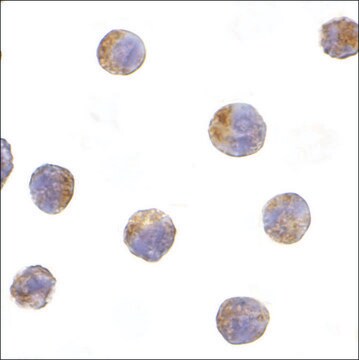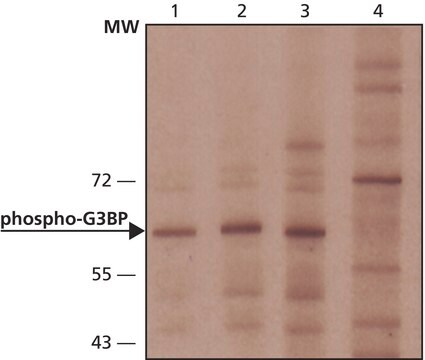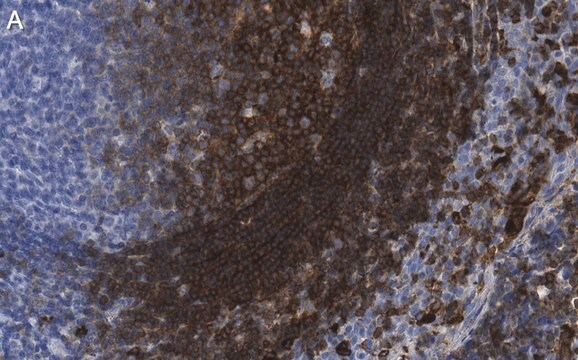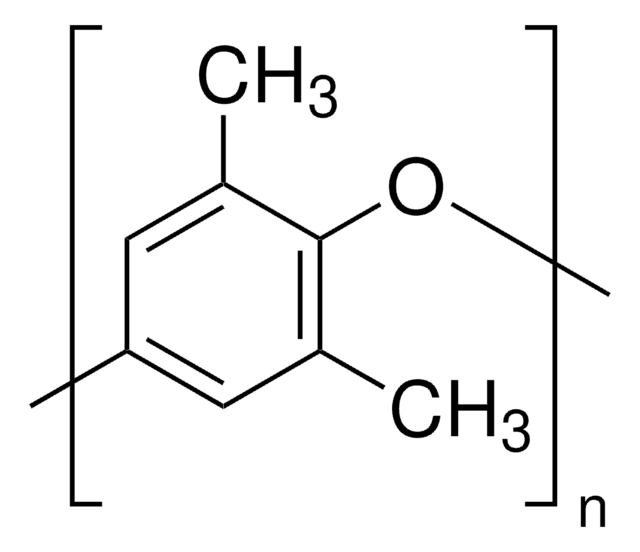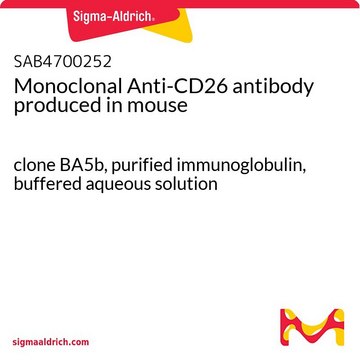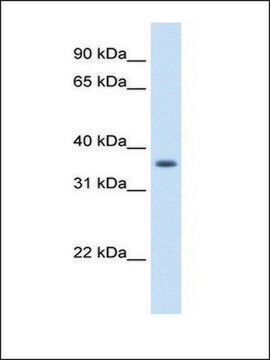おすすめの製品
由来生物
mouse
品質水準
包装
vial of ≥1X10⁶ cells vial
メーカー/製品名
Millipore
テクニック
cell culture | mammalian: suitable
輸送温度
liquid nitrogen
保管温度
−196°C
アプリケーション
- Each vial contains > 1X106 viable cells.
- Cells are tested negative for infectious diseases by a Mouse Essential CLEAR Panel by Charles River Animal Diagnostic Services.
- Cells are verified to be of mouse origin and negative for interspecies contamination from human, rat, Chinese hamster, Golden Syrian hamster, and nonhuman primate (NHP) as assessed by a Contamination Clear panel by Charles River Animal Diagnostic Services
- Cells are negative for mycoplasma contamination.
特徴および利点
The MEF SQSTM1 G427R cell line contains a FLAG-tagged SQSTM1 protein in addition to the G427R mutation which can be used to study the underlying mechanisms of selective autophagy, ALS-FTLD disease pathogenesis, and oxidative stress mechanisms.
ターゲットの説明
Amyotrophic Lateral Sclerosis (ALS) and Frontotemporal Lobar Degeneration (FTLD) are complex major neurodegenerative diseases that are not fully understood. ALS is characterized by loss of motor neurons in the brain and spinal cord while FTLD is typically characterized by degeneration of neurons in the frontal and anterior temporal lobes. Further understanding of both disorders has led them to be categorized under part of the same disease spectrum. They also share common features such as protein and protein-RNA aggregation in motor neurons. This ultimately implicates a problem in key autophagy pathways.
Recent data suggests that TBK1 and SQSTM1 mutations linked with ALS and FTLD disrupt selective autophagy, resulting in neurotoxicity.1 SQSTM1 is an autophagy receptor protein that mediates the selective autophagy of damaged cell components or proteins that frequently aggregate. The commonality of SQSTM1-associated neuronal inclusions in ALS-FTLD patients appears to indicate its importance as a cellular stress response in which SQSTM1 protein is overproduced to try and clear protein aggregates. It also functions in other signaling pathways such as oxidative stress which has emerged as a contributing factor in ALS.1 SQSTM1 helps regulate oxidative stress through the KEAP1-NFE2L2 pathway in which SQSTM1 binds with KEAP1 resulting in a downstream antioxidant response. Interestingly, a G427R mutation appears to significantly disrupt this pathway, resulting in a highly impaired NFE2L2 response.
The MEF (Mouse Embryonic Fibroblast) SQSTM1G427R cell line contains a FLAG-tagged SQSTM1 protein in addition to the G427R mutation which affects the Ubiquitin Binding Associated (UBA) domain of the SQSMT1 protein. This cell line can be utilized to continue studying the underlying mechanisms of selective autophagy, ALS-FTLD disease pathogenesis, and oxidative stress mechanisms. Furthermore, understanding of SQSTM1 and ALS-FTLD related mutations remains highly important as neurodegenerative diseases continue to increase in prevalence.
Source
Cell line was derived from immortalized p62/SQSTM1-deficient mouse embryonic fibroblasts (MEFs) which were established by infecting MEFs with a recombinant retrovirus carrying a temperature-sensitive simian virus 40 large T antigen. Flag-SQSTM1-WT was also cloned into the HindIII and Xhol sites of the LPC retroviral vector before undergoing site-directed mutagenesis to obtain the SQSTM1G427R genotype.
<underscore><bold>References</bold></underscore>
Deng Z, Lim J, Wang Q, Purtell K, Wu S, Palomo GM, Tan H, Manfredi G, Zhao Y, Peng J, et al. 2019 Jul 30. ALS-FTLD-linked mutations of SQSTM1/p62 disrupt selective autophagy and NFE2L2/NRF2 anti-oxidative stress pathway. Autophagy.:1–15.
Recent data suggests that TBK1 and SQSTM1 mutations linked with ALS and FTLD disrupt selective autophagy, resulting in neurotoxicity.1 SQSTM1 is an autophagy receptor protein that mediates the selective autophagy of damaged cell components or proteins that frequently aggregate. The commonality of SQSTM1-associated neuronal inclusions in ALS-FTLD patients appears to indicate its importance as a cellular stress response in which SQSTM1 protein is overproduced to try and clear protein aggregates. It also functions in other signaling pathways such as oxidative stress which has emerged as a contributing factor in ALS.1 SQSTM1 helps regulate oxidative stress through the KEAP1-NFE2L2 pathway in which SQSTM1 binds with KEAP1 resulting in a downstream antioxidant response. Interestingly, a G427R mutation appears to significantly disrupt this pathway, resulting in a highly impaired NFE2L2 response.
The MEF (Mouse Embryonic Fibroblast) SQSTM1G427R cell line contains a FLAG-tagged SQSTM1 protein in addition to the G427R mutation which affects the Ubiquitin Binding Associated (UBA) domain of the SQSMT1 protein. This cell line can be utilized to continue studying the underlying mechanisms of selective autophagy, ALS-FTLD disease pathogenesis, and oxidative stress mechanisms. Furthermore, understanding of SQSTM1 and ALS-FTLD related mutations remains highly important as neurodegenerative diseases continue to increase in prevalence.
Source
Cell line was derived from immortalized p62/SQSTM1-deficient mouse embryonic fibroblasts (MEFs) which were established by infecting MEFs with a recombinant retrovirus carrying a temperature-sensitive simian virus 40 large T antigen. Flag-SQSTM1-WT was also cloned into the HindIII and Xhol sites of the LPC retroviral vector before undergoing site-directed mutagenesis to obtain the SQSTM1G427R genotype.
<underscore><bold>References</bold></underscore>
Deng Z, Lim J, Wang Q, Purtell K, Wu S, Palomo GM, Tan H, Manfredi G, Zhao Y, Peng J, et al. 2019 Jul 30. ALS-FTLD-linked mutations of SQSTM1/p62 disrupt selective autophagy and NFE2L2/NRF2 anti-oxidative stress pathway. Autophagy.:1–15.
保管および安定性
MEF SQSTM1 G427R cells should be stored in liquid nitrogen. The cells can be cultured for at least 10 passages without significantly affecting cell marker expression and function.
その他情報
This product is intended for sale and sold solely to academic institutions for internal academic research use per the terms of the “Academic Use Agreement” as detailed in the product documentation. For information regarding any other use, please contact licensing@milliporesigma.com.
免責事項
Unless otherwise stated in our catalog or other company documentation accompanying the product(s), our products are intended for research use only and are not to be used for any other purpose, which includes but is not limited to, unauthorized commercial uses, in vitro diagnostic uses, ex vivo or in vivo therapeutic uses or any type of consumption or application to humans or animals.
保管分類コード
10 - Combustible liquids
WGK
WGK 2
引火点(°F)
Not applicable
引火点(℃)
Not applicable
適用法令
試験研究用途を考慮した関連法令を主に挙げております。化学物質以外については、一部の情報のみ提供しています。 製品を安全かつ合法的に使用することは、使用者の義務です。最新情報により修正される場合があります。WEBの反映には時間を要することがあるため、適宜SDSをご参照ください。
Jan Code
SCC467:
試験成績書(COA)
製品のロット番号・バッチ番号を入力して、試験成績書(COA) を検索できます。ロット番号・バッチ番号は、製品ラベルに「Lot」または「Batch」に続いて記載されています。
ライフサイエンス、有機合成、材料科学、クロマトグラフィー、分析など、あらゆる分野の研究に経験のあるメンバーがおります。.
製品に関するお問い合わせはこちら(テクニカルサービス)
